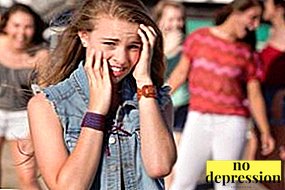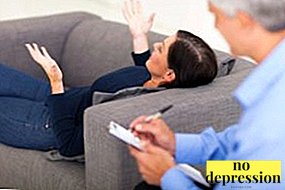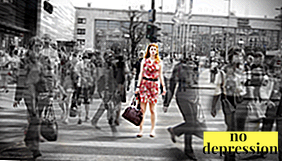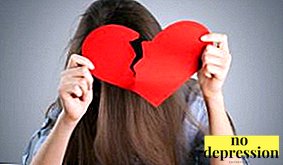Agoraphobia - what is it in psychiatry? In a broad sense, agoraphobia is fear of open spaces. The manifestation of a phobia can be accompanied not only by psychological, but also by physical signs.
The initial stages and severe forms of the phobic state differ in the intensity of symptoms. Agoraphobia should be treated as early as possible.
Otherwise, complications can provoke progression of mental disorders, which will be much more difficult to eliminate.
Concept and features

Agoraphobia called mental disorder, manifested in the form of fear of crowded places and open spaces (doors).
Provoke a panic attack may shopping centers, markets, public transport, open doors and other factors.
At the time of the attack of agoraphobia, the patient experiences a strong emotional shock. The object of fear can be specific or be a combination of several stimuli at the same time.
Features of phobia:
- In most cases, the first symptoms of agoraphobia appear in 20-25 years.
- Agoraphobia belongs to the category of pathologies of the neurotic spectrum.
- The tendency to phobias, manifested in the form of fear of open spaces, in most cases occurs among residents of large cities (for those who live in villages, towns or small cities, the risk of such a phobia is minimal).
- Women are at risk (women are distinguished by a heightened sensitivity of the psyche and emotionality).
Agoraphobia - what is it? Find out from the video:
Kinds of frustration

The object of agoraphobia is not so much the accumulation of people or open space, as many specific dangerwhich sees agoraphob in such factors.
Causes of fear can be fear of death or injury, attacks of specific diseases, infection with infections and other fears.
In some cases, agoraphobia develops simultaneously with other types of phobic states or is their complications.
At the time of the attack of agoraphobia people may experience following fears:
- fear of heart failure;
- fear of death;
- fear of deprivation of mind;
- fear of lack of air;
- fear of disorientation (inability to get out of the crowd);
- fear of humiliation if outsiders notice a panic attack;
- fear not to get help from people.
Causes of phobias
In most cases, the occurrence of agoraphobia is associated with previously experienced situations in which a person has experienced extreme emotional shock.
The source of the danger should be a large crowd of people in the open area.
Experts do not exclude genetic predisposition to this type of phobia. Most phobic conditions are transmitted from parents to children.

Possible causes agoraphobia can be the following factors:
- complications and progression of other mental disorders;
- uncontrolled intake of drugs from the category of tranquilizers or hypnotic drugs;
- alcohol and drug abuse;
- severe stressful situations associated with large crowds of people;
- constant stressful situations and situations that traumatize the psyche;
- increased emotionality and excessive sensitivity of the psyche;
- experienced in childhood situations that traumatize the psyche;
- progression of neurocirculatory and vegetative-vascular dystonia;
- accentuated personality type (tendency to exaggerate the value of certain factors);
- propensity to depressive states.
Symptoms and signs
The main manifestation of agoraphobia is the occurrence panic attack while in open spaces.
A strong sense of fear arises in paroxysmal form and can last up to thirty minutes.
At the moment of attack, the agoraphob is experiencing not only anxiety, trying to leave potentially dangerous place but can also lose the ability to control their own behavior. In most cases, the vegetative symptoms join the emotional signs of agoraphobia.
At the time of the attack of panic attack agoraphobic may experience the following conditions:
 shallow and accelerated breathing;
shallow and accelerated breathing;- increased heart rate and symptoms of tachycardia;
- redness or blanching of the skin;
- sensation of heat (may be supplemented by fever);
- fainting and general weakness of the body;
- disruption of the digestive system;
- vomiting or nausea;
- headache and dizziness;
- violation of the vestibular apparatus;
- chills and tremor of the limbs;
- sudden and sudden adrenaline rush;
- "Ringing" in the ears and visual impairment;
- difficulty swallowing.
How to treat agoraphobia? About which psychotherapeutic approaches most effective in treating a similar phobia, in this video:
How to overcome the fear of open space?

How to get rid of agoraphobia? With the progression of agoraphobia, the patient may refuse to leave your home.
In such cases, there is a need for urgent medical care. To cope with this form of phobia on its own will be impossible.
If the patient is able to control his behavior and emotional state, then the development of agoraphobia can be prevented by the method of corrective therapy, taking special medications and exercises that can be performed at home.
Medications
To eliminate agoraphobia used tranquilizers and antidepressants. Most drugs of these categories has a side effect of addiction to them organism. To exclude such an action, specialists make treatment regimens individually.
Dosages change during the course of therapy. Independent or uncontrolled intake of such drugs increases the risk of complications.
When treating agoraphobia can be assigned selective serotonin reuptake inhibitors of monoamine oxidase, drugs from the group of benzodiazepines, as well as sedatives (including homeopathic medicines).
Kinds medicationused in the treatment of agoraphobia:
 Atarax (a sedative that has a pronounced anti-anxiety effect);
Atarax (a sedative that has a pronounced anti-anxiety effect);- Moclobemide (the drug blocks certain groups of enzymes, arresting the symptoms of a phobia);
- Sertralin (the drug increases the concentration of serotonin in the nervous tissue);
- Paroxetine (a drug from the category of antidepressants, eliminates the symptoms of anxiety and prevents panic attacks);
- Carbamazepine (the drug has a general beneficial effect on mood and psyche, eliminates the symptoms of irritability, aggressiveness and nervous over-excitement).
Psychotherapy
Using psychotherapy methods is priority area in the treatment of agoraphobia. Based on the first results of such procedures, the need to supplement them with special medications is determined.
The duration of the psychotherapeutic course depends on the individual characteristics of the psycho-emotional state of agoraphoba and the stage of progression of the mental disorder.
The following psychotherapy methods are used in the treatment of agoraphobia:
- The method of "flood" or "shock" therapy (the doctor introduces him into a potentially dangerous situation without warning the patient; during a panic attack, the specialist uses special techniques to influence his subconscious, the method has some contraindications and should be carried out only by a doctor).
 Psychodynamic psychotherapy (the task of this technique is to identify the patient’s fears and determine their boundaries; a further course of psychotherapeutic techniques is selected on the basis of the collected data).
Psychodynamic psychotherapy (the task of this technique is to identify the patient’s fears and determine their boundaries; a further course of psychotherapeutic techniques is selected on the basis of the collected data).- Hypnosis method (in psychological and psychiatric practice, this technique is among the most effective ways to eliminate phobias).
- Cognitive psychotherapy (the main stages of the methodology are identifying the wrong thoughts of agoraphobe, moving him away from existing fears, replacing pathological persuasion and subsequent consolidation of the result, checking the developed skills of self-control).
- Behavioral psychotherapy (The specialist identifies the specific fears that provoked agoraphobia in the patient, highlights the situations that cause the smallest and greatest attacks of panic attack, selects ways to correct the agoraphobe response to these stimuli as they increase).
Agoraphobia. Self-help methods for panic attacks:
Exercise yourself

If suspicion of agoraphobia occurs, it is recommended do not share the problem with people around you.
Relatives may aggravate the situation, constantly expressing their experiences and being interested in the state of agoraphoba.
This recommendation applies only to mild phobias. If you experience uncontrollable fears or complications, it is imperative to seek the help of psychologists and psychotherapists.
Own forces to eliminate the severe forms of phobic states will not work.
Recommendations for combating the first appearances of agoraphobia:
- Autotraining (self-suggestion method, which includes the awareness of fears, the improvement of personal qualities and self-control).
- If alarms occur before visiting open spaces you should try distract from the object of fear (think about pleasant events, draw up a daily routine, analyze situations that do not have a negative impact on the psyche).
- Required carefully examine the roomin which the maximum feeling of relaxation and comfort is felt, to identify an object or several objects that create a feeling of peace, when signs of a panic attack occur, a mental representation of sedative factors will help to cope with anxiety.
- Visualization of fear (for classes, you need to prepare two types of pictures - images of potentially dangerous situations and neutral photos of nature, for a few seconds you need to carefully examine the picture, which brings mental discomfort, then quickly change it to a nice image).
- If an alarm occurs when you are in a place where there is a large crowd of people, you can use headphones to listen to your favorite music, mentally imagine the pacifying pictures (blue sky, sea, beautiful landscapes).
 Technician mastering has good results. breathing exercises and relaxation (it is possible to use such techniques to eliminate anxiety states and as their prevention).
Technician mastering has good results. breathing exercises and relaxation (it is possible to use such techniques to eliminate anxiety states and as their prevention).
Favorable prognoses with agoraphobia are possible only in the case of timely treatment of mental disorder.
Otherwise, a phobia can not only dramatically change the quality of life, but also cause the development of additional diseases associated with the psycho-emotional state of a person. Pathological processes in the subconscious will become irreversible.
In this video you will find basic recommendationshow to start moving on your own with panic attacks! 7 steps to cope with fear:

 shallow and accelerated breathing;
shallow and accelerated breathing; Atarax (a sedative that has a pronounced anti-anxiety effect);
Atarax (a sedative that has a pronounced anti-anxiety effect); Psychodynamic psychotherapy (the task of this technique is to identify the patient’s fears and determine their boundaries; a further course of psychotherapeutic techniques is selected on the basis of the collected data).
Psychodynamic psychotherapy (the task of this technique is to identify the patient’s fears and determine their boundaries; a further course of psychotherapeutic techniques is selected on the basis of the collected data). Technician mastering has good results. breathing exercises and relaxation (it is possible to use such techniques to eliminate anxiety states and as their prevention).
Technician mastering has good results. breathing exercises and relaxation (it is possible to use such techniques to eliminate anxiety states and as their prevention).

